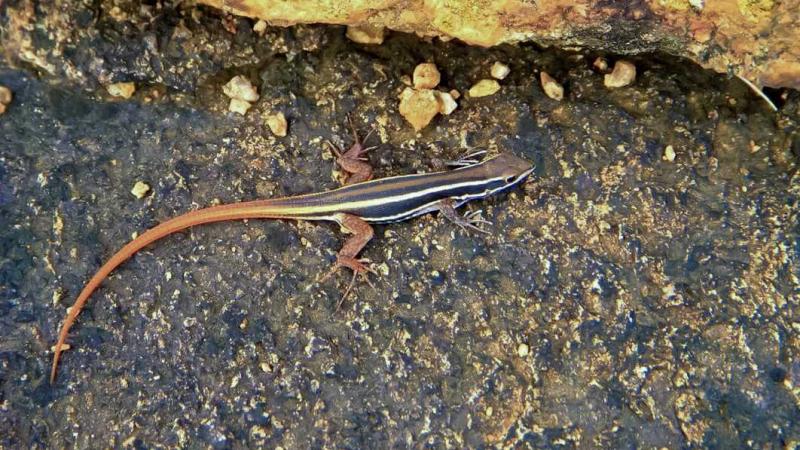
A new study suggests that stripes and colourful tails of some lizards may help them ward off predators
The black and white stripes of a zebra may be attractive to us, but did you know they evolved so to confuse predators? Called ‘motion dazzle’, the lines make it hard for the predator, to judge the speed and direction of the moving prey. This strategy was also used during World War I where navy ships were painted with black and white patterns to avoid being attacked by torpedo missiles from submarines. In a recent study, researchers from the Indian Institute of Science Education and Research Thiruvananthapuram (IISER-TVM) and the University of Turku, Finland, have studied the motion dazzle effect in lizards. The study, published in the Journal of Evolutionary Biology, is one of the first to use data from real animals to understand this phenomenon and its evolutionary significance.
Some lizards, like Eutropis bibronii—a species of skink from India—have longitudinal body stripes, and Lygosoma punctata—a common species of skink found in parts of South and Southeast Asia—have both longitudinal stripes and a colourful tail. Previous studies have shown that body stripes and striking colouration on the tail deflect predators to attack the tail instead of the body, giving a chance for the lizard to escape.
“In some lizards, the tail can be lost and regrown, the stripes on the body might create an illusion in such a way that the predator ends up catching the tail instead of the main body during motion”, says Gopal Murali from IISER-TVM, who is the lead author of the study. The study was funded by the Department of Science and Technology and IISER-TVM.
The researchers of the current study started with several hypotheses of correlations between the colour patterns and ecological traits of lizards based on the principle of motion dazzle (for stripes) and attack deflection (for colorful tail). They tested these hypotheses by analysing nearly 8000 lizard photos from over 1600 different species.
The researchers found that striped species of lizards, like Eutropis bibronii, had a higher body temperature than those without stripes. The mobility of ectothermic animals—animals that cannot regulate their body temperature—depends on their body temperature. Thus, lizards with longitudinal stripes and higher body temperature have higher mobility and can rapidly escape from predators.
“This correlation is expected because motion dazzle patterns work only when the animal is in motion”, adds Murali.
Interestingly, the study also found that both body stripes and colourful tails are associated with diurnal behaviour, where the lizards are active during the daytime. This association could be because the colourations may be ineffective in the dark against predators that rely on sight. The researchers suggest that body stripes and colourful tails likely evolved in lizards that are active during the day.
Besides, the researchers hypothesized that this evolution is also driven by the lizard’s ability to lose its tail. This defence mechanism, known as caudal autotomy, first evolved over 280 million years ago in reptiles. Without it, there would be no benefits for the lizards from deflecting the attacks on their body to their tail! The researchers tested this hypothesis and found evidence to support that these colourations may have evolved with caudal autotomy. Additionally, there was a strong correlation between stripes and tail colouration.
“We speculate one of the reasons to be that the deflective effect of one of the colourations alone can be enhanced by the other”, says Murali.
The findings of the study appear to be supported by observations in real animals and apply to almost all lizard species worldwide. Lygosoma punctata, for example, has longitudinal stripes on its body and a bright red-coloured tail when it is a juvenile. It is known to have many predators including birds, snakes and mammals. It is also diurnal and can lose its tail when attacked, giving it a significant chance of survival. It can thus direct an attack from its body towards its tail. Other lizards, like the Bengal monitor (Varanus bengalensis), have neither any striking colouration nor the ability to lose their tail. Since these large lizards have few natural predators, they did not evolve to develop such defence mechanisms.
The next time you see a lizard with a bright tail or zebra-like stripes on its body, think of the long tale behind the tail!





